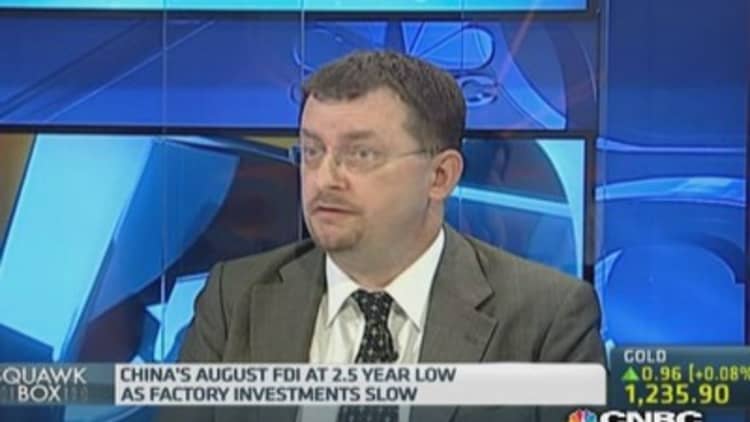
Chinese media reports that the People's Bank of China (PBoC) will provide hefty liquidity injections for its five largest banks are being viewed by some analysts as the major stimulus move markets have been waiting for, but others say something even bigger is round the corner.
The PBoC will distribute 500 billion yuan ($81 billion) to its five largest banks through standing lending facilities - a tool that allows banks and commercial lenders to ask the central bank for one to three-month loans. The move has not been officially confirmed.
"If this is confirmed, it essentially means the PBoC is undertaking quantitative easing; it is printing money and giving capital to banks in the hope they will lend it on," said Evan Lucas, market strategist at IG.
Read MoreIs 80 cents finally in sight for the Aussie?
The report saw copper futures spike 4 percent late Tuesday before retreating, a move so fast and powerful it triggered an automatic 10-second trading pause at the CME Group. Meanwhile, the Australian dollar - which is closely linked to China's economic performance - rallied 1 percent against the U.S. dollar.
Lucas noted the move was not as aggressive as easing measures undertaken in the second quarter. So far, the PBoC has cut the reserve ratio requirement (RRR) -the amount of deposits that banks need to hold at the central bank - for banks with a high proportion of lending to the agricultural sector and small firms.
"However, it is still a stimulus measure and one that has a broader reach, in that this is the first time the largest banks in China have seen a handout in 2014," said Lucas. "This is a rather large change intact considering the talk from Premier Li Keqiang in the last four to five weeks, who has been talking up reforms rather than stimulus."
Something bigger
Other analysts weren't as convinced.
"That lending facility seems to fluctuate quite a bit so I'm not sure if it's much of a change from their previous policy," said Alaistair Chan, China economist at Moody's Analytics. He views the injection as more of a short-term move to smooth fluctuations and wouldn't describe it as 'quantitative easing.'
"The most interesting thing is the fact that it was leaked to Sina.com which suggests the government is thinking about what they are going to do next, which I think will be a broader RRR cut sometime soon," Chan said.
Analysts at Mizuho Securities Asia echoed Moody's Analytics' Chan's view that the move is more of a prelude to something bigger.
"News that China is providing liquidity to the major banks has raised prospects that further targeted measures will support growth in China," Mizuho analysts wrote in a note.
Read MoreChina's reforms reducing hard landing risk: Premier Li
But other analysts said they thought it was more likely that the PBoC would continue down the path of targeted easing measures.
Uwe Parpart chief strategist at Reorient Group, wrote in a note that the PBoC is playing it safe through the liquidity injection.
In order to boost growth, he said, the bank needs to adopt additional stimulus measures, such as lower mortgage rates, permission for more medium-term note issuance by listed property developers (as initiated in early September), and accelerated fiscal spending.
"Over the past several months, we have been calling for an actual across-the-board traditional interest rate cut. With the SLF stimulus, such a rate cut has become less likely, but we continue to believe it would be the best option," he added.
Meanwhile, analysts at Morgan Stanley bank said the central bank's liquidity injection was akin to a 50 basis point RRR cut with three month duration, but said the move showed policy makers were resisting the pressure to cut interest rates or reduce the RRR universally by opting for more conditional easing.
China's economy has suffered a series of weak economic data points recently. Data released over the weekend showed industrial production growth slowed to 6.9 percent on year in August, its lowest level since the global financial crisis.
The nation's slowing property market - which accounts for around 15 percent of total gross domestic product - has also been a cause for concern. Average new home prices in 70 major Chinese cities fell 0.9 percent in on month July, following a 0.5 percent decline in June.


